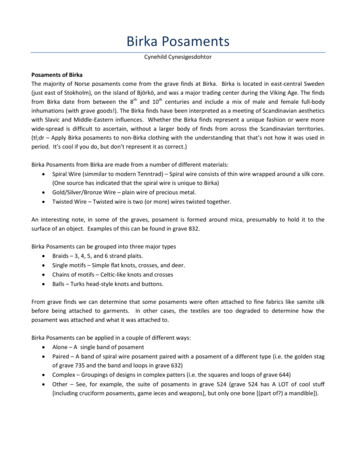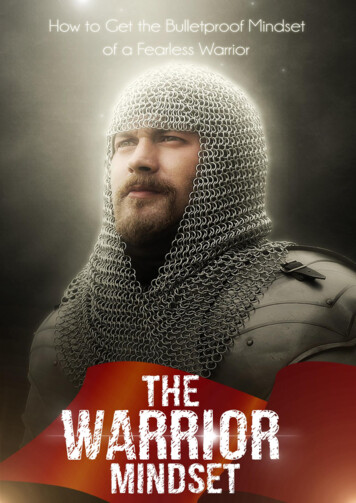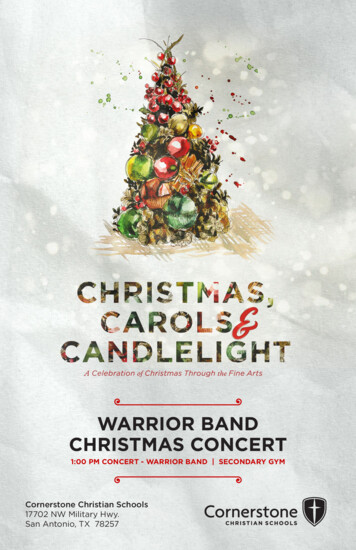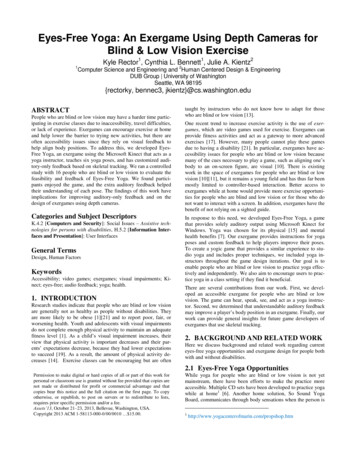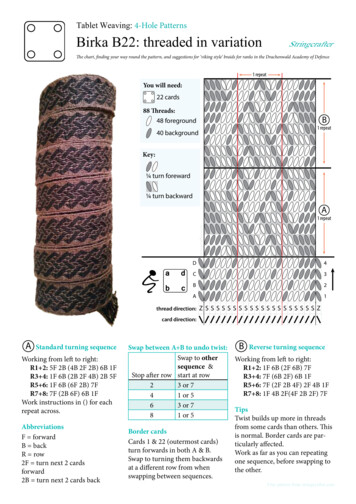
Transcription
THE BIRKA WARRIORThe material culture of a martial societyCharlotte Hedenstierna-JonsonStockholm University
Doctoral Thesis in Archaeological Science 2006Stockholm UniversityAbstractThis is a study of martial material culture in the context of the Viking Age warrior ofBirka, Sweden. The aim is to establish the role, function and affiliation of the Birka warrior and thereby place Birka on the power-political map of the 10th century. The study isbased on the excavations of the fortified structures, particularly the Garrison, at the trading post of Birka as well as the extensive remains of material culture deriving from theseinvestigations. A starting hypothesis is that an analysis of material culture constitutes away of mapping social structures and that style and iconography reflect cultural groups,contacts and loyalties.Based on the case studies of six papers, the synthesis deals with questions of the workand world view of the warriors, as too their relation to their contemporary counterparts ineastern and western Europe. Questions are raised concerning the value and function ofsymbols in a martial context where material culture reflects rank, status and office. Indefining the Birka warrior’s particular stylistic expression, a tool is created and used in thesearch for contacts and affiliations reflected through the distribution patterns. The resultsshow close contacts with the eastern trading posts located on the rivers Volga and Dnjeprin Ancient Russia.It is stated that these Rus’ trading posts, essentially inhabited by Northmen, shared acommon cultural expression that was maintained throughout a vast area by exceptionallyclose contacts. It is suggested that a particular stylistic expression developed in these Rus’trading places containing elements of mainly Scandinavian, Steppe nomadic and Byzantine origin.In conclusion, the results of this thesis show that the warriors from Birka’s Garrisonhad a share in the martial development of contemporary Europe but with their own particular traits. Close relations with the eastern trade route and contact with the powerfulByzantine Empire were enjoyed. As a pointer for future research, it is wondered whatorganisational form the close-knit structure of the Rus’ trading posts actually took, keeping the subsequent guilds of medieval Europe in mind. The fall of the Garrison, as ofBirka, corresponds with the establishment of Christianity in the region. Such changeswere not limited to Central Sweden but part of a greater process where a new politicalstructure was developing, better anchored in local concerns.Keywords: Birka, martial society, warrior, material culture, distribution patterns, culturalexpression, Rus’, Viking Age, Early Middle Age, iconography, style. Charlotte Hedenstierna-Jonson, Stockholm 2006ISSN 1400-7835ISBN 91-89338-15-4Typesetting: Intellecta DocusysPrinted in Sweden by Intellecta Docusys, Stockholm 2006Distributor: Archaeological Research Laboratory, Stockholm Universityeastern and western warrior. 7th century helmet mount,Vendel XIV. After drawing by O. Sörling.Cover: The
To the Heroes on the Home Front
AcknowledgementsWhen reaching this point in the process of doctoral studies, feelings of gratitude are most apparent and highly apt. Most of all I want to thank my supervisor and project leader Dr Lena Holmquist Olausson, who with a firm butfriendly hand has guided me through these years with never failing enthusiasm.If truth be told I have enjoyed the ride. With generosity she has provided mewith the material and results of one of the most interesting archaeological contexts of recent years – the Garrison at Birka.My deep gratitude is extended to Professor emerita Birgit Arrhenius, my assistant supervisor, who led me down this road in the first place and who hasshared her extensive knowledge and experience along the way. ProfessorKerstin Lidén, who conscientiously contributed with both intellectual and practical help, ensured me a stimulating working environment at the ArchaeologicalResearch Laboratory.I am greatly indebted to Assistant Professor Michael Olausson for challenging me in my theories and encouraging me to be more daring, though stringent,in my conclusions, but first and foremost who has shown me that the glory andsoul of archaeology truly lies in the trenches. Most kindly Professor GustafTrotzig has contributed to my research with numerous foresighted commentsand convivial conversation. I am indebted to Assistant Professor Ingmar Jansson who has given generously of his time and knowledge, and provided mewith a multitude of un-get-at-able books and papers. My gratitude also to Assistant Professor Lennart Karlsson, who introduced me to the world of Northernstyle and who has continuously shown interest in my work, for which I am verygrateful. Dr Uaininn O’Meadhra has revised my English and kindly contributedwith her broad knowledge even regarding the content of the texts. The closeworking relationship I have enjoyed with conservator Honorary Dr MargarethaKlockhoff has been of infinite value for the results of the thesis and has alsoprovided many fine moments at the Laboratory.I would like to direct a very special thanks to my ‘trench-mates’ in the manycampaigns at Birka and at other excavations in Sweden and Macedonia. Youhave all, and perhaps in particular the unofficial society of Mining Horses(Laila, Helena, Niklas, Lotta, Jens, Sara, Cecilia), made excavation a properpleasure. Strength and Honour!All friends at the Laboratory have contributed with good company and generous assistance, making my years there both pleasant and exciting. Manythanks to Lotta Bergström, Gunilla Eriksson, Ann-Marie Hansson, Björn Hjulström, Sven Isaksson, Laila Kitzler Åhfeldt, Anna Linderholm, Anita Malmius,Veronica Nyström, Kjell Persson, Ludvig Papmehl-Dufay, Slavica Petrovski,Sylvia Sandelin and Malgorzata Wojnar-Johansson. This work has benefitedgreatly from the many discussions with friends and colleagues Professor Kennet Jonsson, Dr Fedir Androshchuk, Dr Anna Kjällström, Niklas Stjerna, YlvaStenqvist Millde, Ny Björn Gustafsson and Torsten Svensson – thank you all.
Sällskapet för Svenska Borgstudier has provided a forum for scholarly discussion disguised as pleasant divertissement.Inger Kåberg has been exceedingly helpful in making everything turn fromtext to book. I also want to thank the professional and obliging staff at theLibrary of the Royal Academy of Letters, History and Antiquities. Financialsupport has come from Riddarhuset, Berit Wallenbergs stiftelse, Helge AxsonJohnsons stiftelse, Gunvor och Josef Anérs stiftelse and the Department ofArchaeology and Classical Studies at Stockholm University.Good friends are everything. My most sincere thanks to Monica Edströmand her family for all aspects home life, to Catharina Sitte Durling for your oncampus support, and to Viveca Bjurtoft for being in general a good old friend.Finally there are those who without question have supported me through thickand thin and to whom a thank you does not seem quite enough. Thanks to myparents Lena and Göran Hedenstierna, always encouraging me to do what Ifind most interesting, but also expecting me to do my best. Freedom underresponsibility is a powerful tool when facing the trials of thesis-writing. Sofia,Magnus and Louise, not only for inestimable help with logistics but for all theinterest and support you’ve shown.An indefatigable trio has stood fast by my side through the ups and downsof this work. My wise and considerate husband Staffan, who, apart from offering assistance in every possible way, willingly has discussed the contents of mywork in the perspective of modern politics. August and Arvid, though smallsized knights, have endured it all with unperceived patience and unconditionallove and support. You are truly the heroes on the home front.Charlotte Hedenstierna-Jonson
Contents1. INTRODUCTION.9Terminology . 10THESIS STRUCTURE AND RESULTS. 12Case studies – papers I–VI . 12CONTEXT . 14Birka and its military structures – archaeological background . 16The Eastern connection . 172. WEAPONS, WARFARE AND CULTURAL EXPRESSION .22THE PACIFIED PAST . 22MILITARISED SOCIETY . 24The Retinue system – and the mercenary. 26The Impact of martial society – the honourable warrior. 27Warfare . 30EXPRESSING CULTURE AND IDENTITY. 33Defining style. 34The issue of identity . 36DIFFERENCES IN EXPRESSION – THE GARRISON IN CONTRAST TO THEGRAVES. 373. ARTEFACT, CONTEXT AND DISTRIBUTION.40PARTICULAR DESIGN AND PATTERNS OF DISTRIBUTION . 40Material culture in the light of archaeological science . 424. ON THE MARTIAL SIDE OF BIRKA.46FORTIFICATIONS. 48WORK AND WORLD VIEW OF THE WARRIORS. 53Personal and professional . 53The Dress and equipment of the Birka warrior . 54Organisation and training. 61FIGHTING TECHNIQUES IN RELATION TO THE FORTIFICATIONS OF BIRKA . 66Dominance and defence . 66
5. RUS’, VARANGIANS AND NORTHMEN.71BIRKA AS AN ANOMALY – AND ANALOGY . 71Hedeby and the Danish ring fortresses . 71Eastern analogies . 75RUS’ IDENTITY. 78CREATING A CULTURAL EXPRESSION. 81A typical Rus’ stylistic expression? . 826. THE WARRIORS AND THE BIRKA CONSTRUCT IN THE 10THCENTURY.87AT CLOSE RANGE . 88Birka . 88The warriors . 89Rus’ . 90THE WIDER CONTEXT . 91Placing Birka on the power-political map. 91A change in power-structure . 92The End. 937. SUMMARY.94THE BIRKA WARRIOR – the material culture of a martial society. 94REFERENCES.98
List of papersI.Hedenstierna-Jonson, C. 1998. The study of three mounts fromVendel using laser scanning techniques and surface structure analysis. Laborativ Arkeologi 10–11. Stockholm. 81–84.II.Hedenstierna-Jonson, C. 2002. A group of Viking Age swordchapes reflecting the political geography of the time. Journal ofNordic Archaeological Science 13. Stockholm. 103–112.III.Hedenstierna-Jonson, C. Rus’, Varangians and Birka Warriors.The Martial Society, Aspects on Warriors, Fortifications and Social Change from the Bronze Age to the 18th Century. L. Holmquist Olausson & M. Olausson (eds.). Stockholm. In print.IV.Hedenstierna-Jonson, C. & Holmquist Olausson, L. 2006.The Oriental Mounts from Birka’s Garrison. Antikvariskt arkiv81. StockholmV.Hedenstierna-Jonson, C. Borre style metalwork in the materialculture of the Birka warriors. An apotropaic symbol. Fornvännen101. Journal of Swedish Antiquarian Research. Stockholm. Accepted.VI.Linderholm, A., Hedenstierna-Jonson, C., Svensk, O. & Lidén, K. Diet and status in Birka. Analysis of stable isotopes andgrave goods. Manuscript.
1. INTRODUCTIONThere are many preconceptions concerning the Vikings, ranging from themead-drinking savage with horned helmet of popular culture, to the unsuitability of calling anyone a ‘Viking’ at all. During the 1980s and 90s the imageportrayed in earlier studies of a barbaric yet successful conqueror, was partlyovershadowed by a new image, more or less well formulated, of a friendlytradesman and/or farming settler. Viking Age violence became demoted toa necessary evil, at most, and weapons were reduced to mere symbols ratherthan fighting equipment for active use. An acknowledgement of the importance of warfare and violence in early medieval society has now become atopic of renewed relevance in historical and archaeological studies thatshould even include the Scandinavian/Northern cultural sphere of the time.Despite this newfound interest in warfare-related problems, the paucity ofsource-material for Scandinavian archaeology and history has not permittedthe thorough treatment available in the cases e.g. of the well documentedFranks or Normans. However, with the excavations of the Garrison at theViking Age trading-post of Birka, situated on the island of Björkö in LakeMälar, in eastern central Sweden (fig. 1 & 2), the situation has now changed,at least when it comes to archaeological source-material. This unique andexcessively rich archaeological site, is marked by military activity in the late10th century and provides an unusual insight into the material culture of amartial society in Scandinavia during the Viking Age.The present study has two main aims: The first is to recognise and characterise the Birka warrior and define the particular stylistic expression of his material culture, therebycreating a tool for identifying patterns of artefact distribution thatreflect the movements and contacts of these warriors. The second aim is to employ this tool to uncover the role, organisation and affiliations of the warriors and by doing so, to position thetrading post of Birka within the greater context of power politicsduring the final stages of its existence.9
The study is based on excavation of Birka’s fortified structures and on thefind material and results deriving from these investigations, in particular theresults of excavation of Birka’s Garrison from where an extensive amountof objects have been retrieved, providing a first-hand insight into the life ofthe warrior through his material remains. Questions raised concern the valueand function of symbols in a martial context where material culture reflectsrank, status and office. The diversity of the cultural regions and powerrealms represented in the Garrison evidence begs the question of whom thewarriors actually served. What do the different objects and their connectionswith other archaeological finds indicate in terms of political, diplomatic andmilitary relations and affiliations? Analogies with archaeological material inAncient Russia are presented and discussed in terms of the identity andcultural expressions particular to the group of people called Rus’.The starting hypothesis of this study maintains that an analysis of material culture constitutes a way of mapping social structures and thereby thatstyle and iconography reflect cultural groups, contacts and loyalties. In thisperspective the advantages of research into the material culture of a warriorsociety is obvious, as it constitutes a particularly well-defined and limitedgroup of artefacts whose design and decoration reflect different aspects ofmartial life.TerminologyThe Viking Age, dating from the end of the 8th century to the mid 11th century, comprises the final period of prehistory in Scandinavia, also referred toas the Later Iron Age. This definition in itself creates and enhances the differences between Scandinavia and contemporary early medieval Europe thatactually did not exist. The absence of a written language and the fact thatScandinavia was not yet Christianised constituted important and decisivedifferences indeed, but in many ways this region played an integral part inthe broader cultural development of Europe and maintained an awarenessof and contact with most parts of the then known world.Consequently I will use the term early medieval for the time period inquestion (i.e. AD 750 – 1000; the duration of the activities in the tradingpost of Birka). For contexts restricted to the historic development of Scandinavia, I will use the term Viking Age, as it is well-established in the terminology of Scandinavian historiography.In my previously published case studies (papers I–VI), I used the thenaccepted terms Viking, Viking Age and Scandinavian when referring to thepeople of Viking Age Scandinavia. These classic terms are the subject ofmuch critique in Viking studies today. Eric Christiansen in the introductory10
notes to his work The Norsemen in the Viking Age (2002) challenges thefickle expression ‘Viking’, observing that it has become somewhat of anethnic term, that what is usually meant when using the term ‘Viking’, is people “of Nordic aspect and speech living in Scandinavia and the Norse colonies in the Early Middle Ages” (2002:1). In this context ‘Nordic’ alludes tothe culture of those who were part of the speech community of the OldNorse family of tongues, referred to in the saga literature as Danska Tungo(Christiansen 2002:4). As the language and consequently the historicaldocuments of the runic inscriptions and saga literature possibly constitutethe lowest common denominator, the term Norse should be applicable, butit has become now more or less synonymous with Norwegian. Therefore, inthis synthesis I have chosen to use the term Northmen or people from theNorth (Sw. nordbor) when referring to the people, and Northern whenreferring to their culture (cf. Christiansen 2002:4 who uses Norse and Nordic for these). I retain the term Scandinavia mainly as a geographical term,though I would like to point out that this term has modern connotations, onequal footing to ‘Swede’ and ‘Norwegian’.Finally in this scrutiny of problematic terminology,I would like to explainmy use of the terms warrior as opposed to soldier, and also what the wordprofessionalism implies in this context. When referring to the various maintypes of arms-bearing men, warrior is defined as a man whose vocation iswar, while the soldier has war as his profession (Sanders 1999). Accordingto this definition, the warrior fights for personal recognition and thereforefought as an individual rather than as a member of a disciplined battle order.In turn, the soldier is part of a clearly defined military strategy where honouron a personal level is subordinated. On a more practical note the warriorsupplied his own arms and armour, while the soldier acquired them fromthe lord or king (cf. Pauli Jensen, Jørgensen & Lund Hansen 2003). Whendealing with a martial context like that of Birka’s garrison, these definitionsbecome too blunt, as the Birka construct incorporated significant elementsof both. With regard to vocation and the concept of personal and militaryhonour, these arms-bearing men were clearly warriors but their organisation,system of rank, and advanced forms of warfare techniques which includedfighting in battle formation, signify the soldier. Consequently these men aredefined as professional warriors, the military elite of a martial society devoted to, and living by, their vocation.11
THESIS STRUCTURE AND RESULTSThe six papers constitute case studies where different categories of objectsare presented, stylistically defined and placed in a wider context of culturalexchange and contact networks. The case studies are given a conceptualfooting in chapter 2 where previous research and my personal standpointconcerning weapons, warfare and cultural realms are integrated to form thetheoretical framework of the thesis. In order to define the particularity ofthe warrior’s material culture, the artefacts, their context and distribution areset in focus in chapter 3 where the different methods applied in the casestudies are presented. The archaeological context of the unique find materialfrom Birka’s Garrison is presented in chapter 4 and the martial aspects ofBirka are discussed. The Garrison constitutes an anomaly in Viking AgeScandinavia and therefore it is necessary to place the material in a widerperspective in order to understand its role, function and importance. Chapter 5 is dedicated to the Eastern analogies of the Birka warriors and to thequestion of a stylistic expression particular to the Rus’, Varangians andNorthmen in Ancient Rus’. Finally, in chapter 6, conclusions are drawnconcerning the greater power-political context of the Birka construct and ofits warriors during the 10th century, based on the collected results of the casestudies.Case studies – papers I–VIPaper I is a methodological study on the application of laser scanning techniques and surface-structure analysis to archaeological material. The aim ofthe study was to establish if the method can provide new knowledge aboutornamental details on damaged surfaces where other analytical techniqueshave failed. The results of the study show that the method can supply alimited amount of new information and that further refinement could produce even additional valuable evidence.Paper II is an iconographical study, partly based on surface structureanalysis conducted on a sword chape of a type not previously found inBirka. The particular type of sword chape is defined and a survey of its areaof distribution is presented. The results of the survey reveal that the locations of these finds, though geographically dispersed, show a certain conformity in structure and function. The sites were generally places of local,regional or even inter-regional importance, and the chapes have been retrieved from settlement contexts rather than graves and occur as solitaires,only one in each location. In conclusion of the iconographical study, whichisolates a motif directly paralleled to that of the Jellinge stone in Denmark,the chape is suggested to be a symbol of office related to the Danish court12
and that its distribution consequently should be seen as a reflection of thediplomatic contacts and political relations maintained by that court.Paper III is a similar study focusing on another type of sword chape, inthis case with a motif that has already been linked especially to Birka and itswarriors – ‘the Birka falcon’. In contrast to the chapes in paper II, the falconchapes usually occur in graves, several to the one site but only one in eachgrave. Based on their context and distribution, these chapes have been interpreted as symbols of rank and affiliation to a particular group of warriors,and they are regarded as diagnostic artefacts, interrelating the sites wherethey have been found. As the majority of these sites played key roles in thegeneral economic, political and social growth of Ancient Russia, the warriorswith falcon chapes are discussed in relation to the Rus’ and the Varangians –the two groups of Northmen presented in the contemporary sources asactive agents in that region’s development.Paper IV is an extensive study of the Oriental mounts and the Easternconnotations of objects retrieved from Birka’s Garrison. The mounts derivefrom composite belts, belt pouches and other equipment connected withthe Eastern warrior and are seen as indicators of rank and status, implyingthat some at least of the ideological framework inherent to these mountswas imported together with the objects themselves. The significance of thewarrior belt is particularly emphasised. The mounts from the Garrison havebeen subjected to stylistic and comparative studies, a process where theimportance of close collaboration with the archaeological conservator isemphasised. The results from the stylistic study are supplemented by Scanning Electron Microscope (SEM) analyses of the chemical content of themetal, indicating places of manufacture that lay within the realm of theVolga Bulgars. The particular traits of these oriental-style mounts are defined, their place of origin is discussed, and their distribution is correlatedwith Birka’s other evidence for contacts with corresponding sites along theEastern trade route.Paper V concentrates on the Northern contribution to the stylistic expression of the Birka warrior and asks why this great style (Borre) is confined to particular items of warrior equipment. An iconographical analysis ofthe different elements of the style indicates that its designs incorporateapotropaic qualities appropriate to a martial context. It is also noted that theBorre style can be found in the archaeological material of Ancient Rus’ inthe same manner and context as in Birka, further strengthening the suggested relation between these different sites.Paper VI compares the interpretation of grave goods in a number ofBirka’s graves with the results from dietary studies based on isotope analysis.Starting off with the questions who ate what? where?, the study shows thatthere is a marked anomaly in diet both between women and men, and between men buried with and without weapons. There are strong indications13
that some of the individuals in the graves derive from separate geographicalareas. The results clearly indicate differences among those buried in Birka inrank and status, but also in role and origin. The study also illuminates thecomplexity of the problem of interpreting weapon graves and begs the question of who on the basis of grave material should be considered a warriorand who not.Figure 1. Birka, located in Lake Mälar, Sweden (map by C. Hedenstierna-Jonson).CONTEXTDuring the early medieval period, Central Sweden consisted of several different regions of power and interest, and subsequently separately definedgroups of people. Political power was exercised through the itineration of apolitical leader between different centres of power (Brink 1996:239f). Thisbecomes obvious when studying the affiliations and rulers of Birka. According to the two roughly contemporary sources mentioning Birka: Rimbert’sVita Ansgarii written in the 9th century and Adam of Bremen’s 11th century account of the archbishops of Hamburg-Bremen, the trading post wassituated in the midst of the realm of the Svea kings. Birka constituted themain centre for trade and craftwork during the period between the mid 8thcentury and the end of the 10th century, when the religious centre of theSvea realm was situated in Old Uppsala. Though in agreement on the loca14
tion of Birka, the description given of who had power over the trading postis somewhat ambiguous. According to Rimbert, Birka was a port of trade inthe land of the Swedes (Rimbert chap. 11), whilst Adam of Bremen described it as “a town of the Goths situated in the middle of Sweden not farfrom the temple called Uppsala” (Adam of Bremen, History of theArchbishops of Hamburg-Bremen. Engl. transl. F. J. Tschan, 2002:51). Whatis actually meant in this context by the Swedes (Svear) as opposed to theGoths (Götar) is difficult to establish, but according to Christiansen theSwedish identity involved certain rights, e.g. attending the thing to debateand vote in public affairs and the right to claim tribute from the easternBaltic coastlands (Christiansen 2002:131). The king of Birka, possibly theking of the Svear realm, resided on the neighbouring island of Adelsö (fig.2), commonly seen as an integrated part of the Birka construct. Adelsö had aroyal manor (kungsgård) which was active during the same time-span asBirka, and the manor of Hovgården is usually regarded as having lookedafter the administrative functions of Birka (Carlsson 1997).Figure 2. The Lake Mälar region (m
This is a study of martial material culture in the context of the Viking Age warrior of Birka, Sweden. The aim is to establish the role, function and affiliation of the Birka war- . way of mapping social structures and that style and iconography reflect cultural groups, contacts and loyalties. . than
